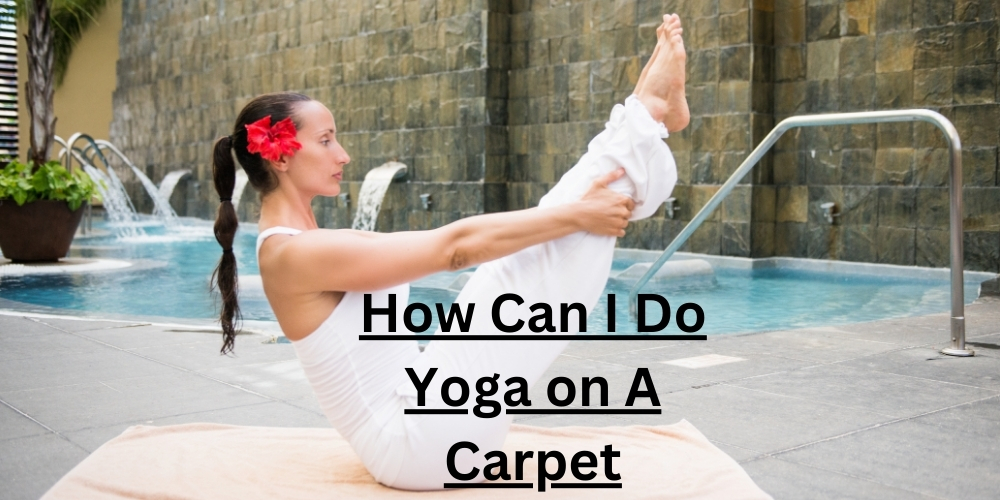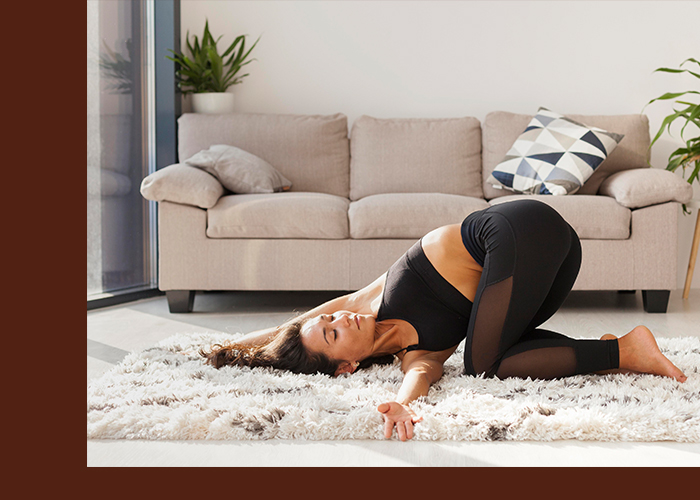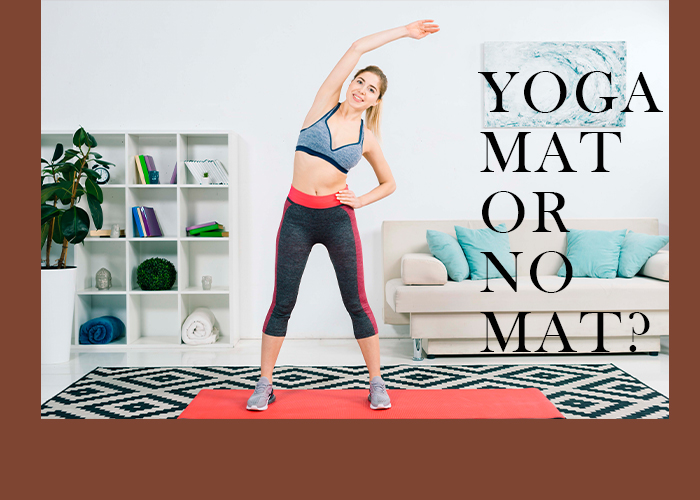Yoga, with its myriad physical and mental benefits, has become a popular choice for many seeking balance and well-being. Yoga practitioners, teachers, and therapists often use high-quality yoga mats for their practice. But is it possible to do yoga on a carpet?
The answer is, you can usually do yoga on a carpet if that’s your preference. Many of you have asked, “How can I do yoga on a carpet?”
Let’s find the answer and learn everything about doing yoga on a carpet.
Yoga On a Carpet Pros & Cons
Pros:
Doing yoga on carpet can be beneficial for your health. One of the benefits is that the carpet protects your joints from stress. This is because the soft carpet surface acts as a buffer for your body. It is also more convenient to practice yoga on a carpet because of less resistance. As a consequence of doing yoga on a carpet, your muscles work more intensely and help you gain more muscle power.
You also feel cozier while doing poses on a carpet than on a floor, especially in the cold season. Since the space is unlimited, there is more room to do the poses comfortably. Carpets come in various thicknesses and textures, allowing practitioners to choose the level of cushioning that suits their preferences. This versatility enables individuals to customize their practice environment.
Using your carpet for yoga is an environmentally friendly choice, as it repurposes an existing household item rather than relying on additional manufactured materials.
However, carpet yoga is also challenging and helps you enhance your overall body stability. Whether it is leg stretches or planks, carpeted floors make it simpler for you.
Cons:
Carpets, especially plush ones, may lack the stability and firmness provided by traditional yoga mats. This can make balancing poses more challenging and may affect the overall stability of your practice. While carpets offer more traction than smooth surfaces, they may not provide the same level of grip as yoga mats with textured surfaces. This can lead to slipping, especially in dynamic or sweaty sessions, posing a risk of injury.
Certain yoga poses involve sliding movements, where a smooth surface is essential. Carpets can create resistance and make these poses less fluid, potentially hindering the intended flow of the practice.
Some people may get rug burns or skin irritations from doing certain yoga poses on the carpet. Also, if your carpet has any lumps—and carpet lumps, often caused by dampness, are common—it may be unpleasant or unstable to push down on them with your hands or feet.
You also have to think about cleanliness and hygiene. When you do any kind of exercise, you leave hair, sweat, and oil on your workout surface. Yoga mats, however, are quite easy to clean by design. Carpets, on the other hand, are more difficult to clean.
Your carpet may also have some dirt in it. Dirt, dust, pet hair, fungus, and other things are common in carpets. When you do yoga on your carpet, these things could get into your mouth, nose, and skin. They could cause allergies or irritation.
Besides, you may tear your rug while doing yoga. Or you may make it flat, create bald spots on it, or make it last shorter because of all the extra damage.
How Can I Do Yoga on A Carpet Correctly
Practicing yoga on a carpet at home can be fulfilling if you maintain certain things. The following are going to help you understand yoga in many ways.
Setting the Scene:
Before diving into your yoga practice, it’s essential to create an environment that fosters relaxation. Choose a quiet and clutter-free space in your home where you can lay down a soft and comfortable carpet. Ensure the lighting is gentle, and add soothing background music to enhance the ambiance. Creating a tranquil atmosphere is crucial for allowing your mind and body to connect during your yoga session.
Selecting the Right Carpet:
Not all carpets are created equal, and choosing the right one for your yoga practice is key. Opt for a carpet that is thick enough to provide cushioning for your joints but not too soft that it hinders stability. A low-pile carpet is preferable as it offers a stable surface for various yoga poses. Ensure the carpet is clean, free of debris, and comfortable to sit and lie down on.
Yoga Mat or No Mat?
While yoga mats are designed specifically for practice, they are not a necessity, especially if you are practicing at home on a carpet. However, if you prefer the extra grip and support a yoga mat provides, you can use it on top of the carpet. This is especially beneficial if your carpet is slippery or if you’re practicing on a hard surface beneath the carpet.
Starting with the Basics:
Begin your yoga session with a few minutes of mindful breathing to center yourself. Focus on deep, rhythmic breaths to clear your mind and prepare your body for the practice. The carpet provides a stable foundation for standing poses, such as Mountain Pose (Tadasana) or Warrior Poses (Virabhadrasana). Pay attention to your alignment and engage your muscles to ensure a safe and effective practice.
Balancing Acts:
Balancing poses, such as Tree Pose (Vrikshasana) or Eagle Pose (Garudasana), can be challenging on a carpet, but they are excellent for building strength and stability. Concentrate on a fixed point to enhance your balance, and don’t be discouraged if you wobble – it’s all part of the journey.
Seated and Supine Poses:
The carpet provides a comfortable surface for seated and supine poses, ideal for postures like Seated Forward Bend (Paschimottanasana) or Corpse Pose (Savasana). Use the carpet’s softness to your advantage, allowing your body to sink into relaxation during these rejuvenating poses.
How Can I Adjust Your Breathing and Focus to Suit the Carpet Surface?
Breathing and focusing are important for any yoga practice, but more so when you do yoga on a carpet. The carpet surface can be annoying, unpleasant, or shaky, so you need to pay attention to your breath and your body to deal with these difficulties.
One way to adjust your breathing and focus on yoga on a carpet is to practice equal breathing. This is a method where you breathe in and out for the same amount of time, creating a smooth and consistent rhythm. You can start with a count of four, then slowly increase it as you feel more comfortable. Equal breathing can help you relax your mind, ease your body, and harmonize your energy.
Another way to adjust your breathing and focus for yoga on a carpet is to use the carpet as a feedback tool. Instead of avoiding or fighting the carpet surface, you can use it to learn more about your practice. For example, you can sense the texture, temperature, and pressure of the carpet on your skin, and observe how it varies with your movements. You can also hear the sound of your breath and the carpet fibers rubbing against each other, and use it as a chant to stay focused.
By adjusting your breathing and focus for yoga on the carpet, you can turn a possible problem into a chance. You can use the carpet to improve your awareness, focus, and relaxation, and make your yoga practice more fun and effective.
FAQ
Can I practice advanced poses on a carpet?
Answer: Yes, you can practice advanced poses on a carpet with proper adaptation. Pay careful attention to your alignment, engage your core muscles, and modify poses as needed to suit the soft surface. Gradually progress and challenge yourself while maintaining mindfulness and breath control.
How does the carpet impact my experience during relaxation poses?
Answer: The carpet provides a comfortable surface for relaxation poses like Corpse Pose. Allow your body to sink into the softness beneath you, and adjust your breathing to a natural, calming rhythm. Use this time to release tension and fully embrace the benefits of your practice.




